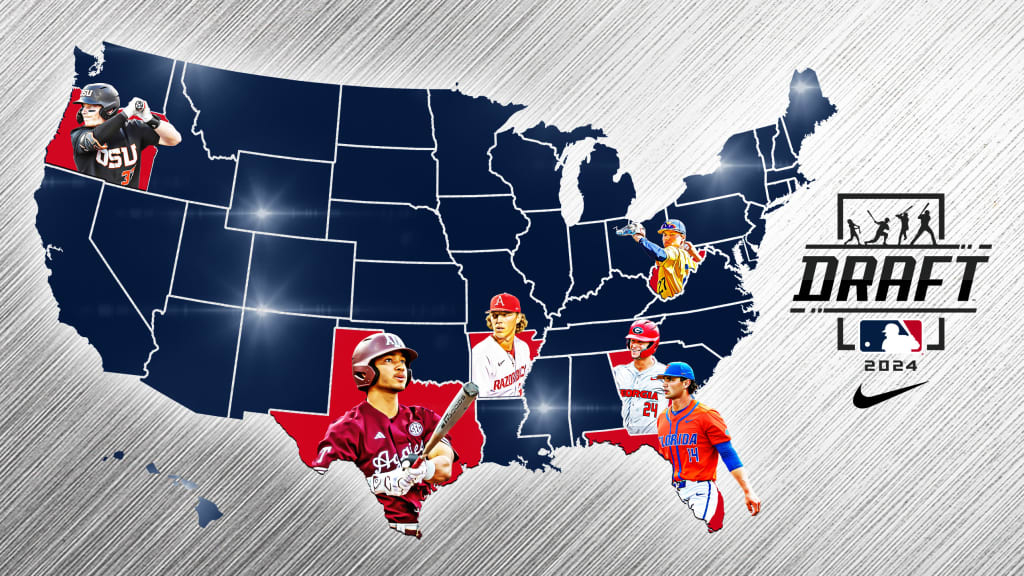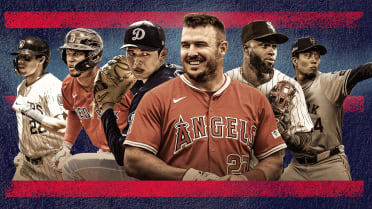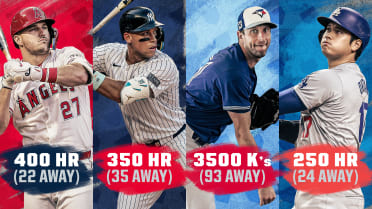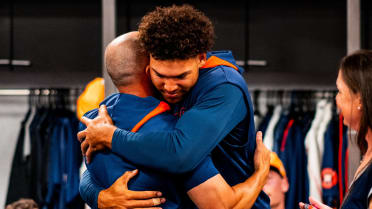
The 2024 Draft arrives Sunday, beginning with a preview show on MLB Network, ESPN, MLB.TV, MLB.com and the MLB app at 6 p.m. ET, and this year’s 20-round process will reverberate through all four corners of the United States as well as Canada and Puerto Rico.
The No. 1 overall conversation could come down to two pure-hitting middle infielders from Oregon State and West Virginia or a legendary slugger from Georgia. The first arm off the board could come from Wake Forest or Arkansas. The race to be the top high-school pick looks to be between one shortstop from California and another from Mississippi. While certain areas of North America will be more well-represented than others, there’s no doubt that the full class will reveal a tapestry of the sport across the continent.
2024 Draft presented by Nike:
Draft Tracker | First-round signings | All-time biggest bonuses
Pick-by-pick analysis: Day 1 | Day 2 | Day 3
Bazzana goes No. 1 | Wake Forest makes history | Mariners nab switch-pitcher | Top 7 Day 1 storylines | Best hauls | Our favorite picks | Famous family ties | Biggest steals | These picks could be new club No. 1's | Picks who could be quickest to bigs | Sons of Manny, Big Papi selected | Complete coverage
As a means of previewing this year’s crop of Draft picks, here are the top 2024 prospects from each state, using assistance from MLB Pipeline’s Top 250 rankings and other input from scouts and evaluators.
Each state is linked to the MLB Draft Tracker’s listing of eligible players from that state. Some states don’t have a player expected to be drafted this year, and not all eligible players are listed in the Tracker.
Alabama: Carter Johnson, SS, Oxford HS (No. 40)
Johnson can handle velocity and show all-fields ability as a left-handed batter, earning a 55 grade for his future hit tool, and there’s potential for 20-plus homers. Average speed might move the Alabama commit off shortstop to either second base or third base, and his above-average arm strength would be a quality fit for the latter.
Alaska: Coen Niclai, C, Service HS
Niclai is a two-time Alaska Gatorade Player of the Year who already participated in the MLB Draft League, slashing .360/.484/.440 over 31 plate appearances with Mahoning Valley this summer. The Oregon commit drew praise during the MLB Draft Combine for his bat speed, defensive skills behind the plate and makeup, and he could be taken as early as Day 2.
Arizona: Cam Caminiti, LHP, Saguaro HS (No. 15)
The 6-foot-2 southpaw will be in heavy consideration to be the first prep pitcher off the board this year, thanks to a 93-95 mph fastball, two solid breaking pitches and an above-average changeup. His overall athleticism (stemming from his time as a center fielder) and repeatable delivery should help him throw strikes at the next level too, boosting his stock to as high as the first half of the first round.
Arkansas: Hagen Smith, LHP, Arkansas (No. 5)
The Golden Spikes Award finalist set an NCAA Division I record with a 17.3 K/9, having struck out 161 in 84 innings for the Razorbacks. His stuff matches the eye-popping stats with a deceptive 94-97 mph fastball that can touch triple-digits, an 83-87 mph sweepy slider that can flash plus-plus and a splitter that provides another look.
California: Bryce Rainer, SS, Harvard-Westlake HS (No. 10)
Teams willing to consider prep bats high up in this year’s Draft will give Rainer a long look this weekend. The Texas commit has five-tool potential with a profile that features loud contact, above-average run times and plus arm strength. He’s answered some defensive questions with improved movements at shortstop and should stick at the six at the next level.
More from MLB Pipeline:
• Spring Breakout | Top 100 prospects | Stats | Video | Podcast | Complete coverage
Canada: Nathan Flewelling, C, St. Josepth (AB) HS (No. 236)
Flewelling beat out Ontario prep right-hander Josiah Romeo by one spot on the MLB Pipeline Top 250 to be the Canadian representative here. The left-handed-hitting backstop showed off impressive exit velocities at the MLB Draft Combine, and his bat speed helps evaluators believe he’ll be an average hitter in the end. The Gonzaga commit is one of the youngest players in the class and won’t turn 18 until November.
Colorado: Trey Gregory-Alford, RHP, Coronado HS (No. 105)
There’s plenty to dream on with the Virginia commit, primarily his 6-foot-5 frame and heater that he can run up to 97 mph already. Gregory-Alford faces some criticism for his lack of a third pitch and some control struggles, but his success in international competition last year (including three saves for Team USA) buoys his stock.
Connecticut: Brady Afthim, RHP, UConn
Afthim served as the closer for a Huskies team that made a surprise run to the Super Regional, and the six-foot right-hander finished with eight saves, a 2.84 ERA and 27 strikeouts in 22 appearances (25⅓ innings). He leans heavily on a fastball that can touch 97, but his low-80s slider and mid-80s changeup have better whiff rates.
Delaware: Nathan Arterbridge, C, St. Georges Technical HS
Delaware’s Gatorade Player of the Year batted .439 with six homers this spring, earning strong reviews from opposing coaches for his power and throwing arm behind the dish. He is committed to Missouri State.
District of Columbia: Everett Catlett, LHP, Georgetown
The 6-foot-7 southpaw towers over the mound and brings a 91-93 mph fastball (touching 96), impressive low-80s slider and upper-80s changeup to the table. He posted a 3.36 ERA with 84 strikeouts in 77 2/3 innings this spring.
Florida: Jac Caglianone, 1B/LHP, Florida (No. 3)
Coming off seasons with 33 and 35 homers, Caglianone has some of the best power in the 2024 class, and he became extremely adept at avoiding strikeouts this spring with only 26 over 316 plate appearances, despite some elevated chase rates. He can touch triple-digits on the mound and got a ton of swing-and-miss with his changeup, but any teams considering the Gators star in the first five picks likely sees him as a full-time position player moving forward.
Georgia: Charlie Condon, OF/3B, Georgia (No. 2)
Condon led Division I in average (.433), slugging (1.009), OPS (1.565) and home runs (37) on his way to winning the Golden Spikes Award this spring. The 6-foot-6 right-handed slugger earns at least plus grades for his hit and power tools, and his below-average speed has many thinking he’s headed for a corner-outfield spot long-term.
Hawaii: Jace Souza, OF, Kamehameha HS (No. 186)
Souza could follow in the footsteps of 2023 third-rounder Devin Saltiban as a Day 2 selection out of Hawaii. The Texas Tech commit shows plus speed on the basepaths and in center field, and he has a smooth left-handed swing that could help provide offensive value as well.
Idaho: Dax Whitney, RHP, Blackfoot HS (No. 56)
The 6-foot-5 right-hander showed a nice velocity bump this spring with a 90-94 mph fastball. His curveball and slider give him two potentially above-average breaking pitches as well, helping his chances at being Idaho’s first prep pitcher to sign out of the Draft since 1967.
Illinois: Ryan Sloan, RHP, York HS (No. 19)
The raw skills and size are there for the Wake Forest commit. Sloan stands in at 6-foot-5 and 220 pounds already at 18 years old. His 93-96 mph fastball and mid-80s changeup look like potential plus pitches, and his low-80s slider could be above-average too, allowing Sloan to cash in nicely as a cold-weather arm.
Iowa: Brody Brecht, RHP, Iowa (No. 21)
Few pitchers can rival Brecht for pure stuff. The former Hawkeyes wide receiver shows a 96-99 mph fastball and 87-89 mph slider that each get plus-plus grades, and some team pitching departments might be salivating to get their hands on both pitches. His rough control history (6.8 BB/9 in college) keeps him out of the MLB Pipeline Top 20 heading into the weekend.
Indiana: Connor Foley, RHP, Indiana (No. 106)
Foley transitioned into a starting role with the Hoosiers this spring and finished with a 4.71 ERA, 82 strikeouts and 49 walks in 63 innings. His 93-95 mph fastball gets the most attention for its induced vertical break, but the 6-foot-5 right-hander will need to improve his control to stick as a pro starter.
Kansas: Kaelen Culpepper, SS, Kansas State (No. 31)
Culpepper gave his stock a nice boost by hitting for the cycle against Lousiana Tech on May 31 in the NCAA regional and hitting a go-ahead homer off Hagen Smith a day later. The latter was huge for a player who faced power questions after slugging .318 in the Cape Cod League last summer. Culpepper could be an above-average hitter in the end, and if he needs to move off shortstop, he would have Gold Glove capabilities at third.
Kentucky: Ryan Waldschmidt, OF, Kentucky (No. 23)
A torn ACL from the Cape last year didn’t ruin Waldschmidt’s chances of going in the first round. The right-handed slugger gained speed throughout the spring and has the right balance of approach and power to be an impressive all-round hitter. He might be a candidate to move from left field to center in the pros, and that could determine his Draft position Sunday.
Louisiana: William Schmidt, RHP, Catholic HS (No. 16)
The 6-foot-4 right-hander has arguably the best curveball in the class – a low-80s breaker that can top 3,000 rpm of spin and show tons of break. His mid-90s fastball is impressive too, and he might still have some to grow. He has arguably the highest ceiling of any prep pitcher this year, even if he’ll wait a little bit to hear his name called because of his righty high-school profile.
Maine: Jeremiah Jenkins, 1B, Maine (No. 199)
While other power hitters get more attention in this class, there is no arguing the fact that Jenkins went deep at least 20 times in each of the last two seasons with the Black Bears. His stance can look a little funky at times as he stands upright, but he can fire his hands through the zone to get to that impressive pop.
Maryland: Jake Yeager, RHP, Archbishop Spalding HS
This year’s Maryland Gatorade Player of the Year, Yeager can look like all-limbs in his delivery, which features impressive extension from a 6-foot-4 frame, and the Maryland commit will place his low-90s fastball right on top of his hitters and get whiffs with a low-80s curveball.
Massachusetts: Mike Sirota, OF, Northeastern (No. 50)
Sirota was trending toward being a first-rounder but saw his power output drop from 18 homers in 2023 to only seven this spring, causing his stock to tumble. Some evaluators saw the issue as relating more to timing than strength, and if the Huskies star can get that back, then he has 20-20 potential, given his plus speed.
Michigan: Dante Nori, OF, Northville HS (No. 48)
Nori – the son of Minnesota Timberwolves assistant coach Micah Nori – gets his best grades for his near-plus-plus speed, and he’s considered a certain center fielder at the next level. The Mississippi State commit also impresses with a line-drive approach in games and an ability to cut down strikeouts.
Minnesota: Connor Wietgrefe, LHP, Minnesota
The 6-foot-2 southpaw was a first-team All-Big Ten selection for the Golden Gophers, thanks to his 2.77 ERA and 74 strikeouts in 78 innings. He works 90-94 mph with his fastball and has a low-80s slider that plays well from his three-quarters slot.
Missouri: Cole Gibler, LHP, Blue Springs HS (No. 128)
Gibler is a floor-over-ceiling left-hander with an above-average curveball around 80 mph, a promising sinking changeup in the mid-80s and a simple delivery that helps him throw strikes. His 89-92 mph fastball leaves some velo to be desired, and he has a commitment to Arkansas, where he could contribute quickly if he doesn’t go high enough this summer.
Mississippi: Konnor Griffin, SS/OF, Jackson Prep HS (No. 9)
The highest-ranked high schooler on this year’s list, Griffin already looks the part of a quality pro ballplayer at 6-foot-4, 215 pounds, and he has four tools (power, run, arm, field) that grade out as at least plus. A lengthy right-handed swing may make him just average in terms of overall hitting, but the ceiling is certainly enticing for any club drafting in the first dozen spots this year.
Montana: None
Nebraska: Tyson Lewis, SS, Millard West HS (No. 39)
The Nebraska Gatorade Player of the Year was a Super 60 Pro Showcase standout back in February, especially when showing off speed in the 60-yard dash. He can be a tinkerer at the plate with his stance, but overall, he has the bat speed and strength to be a decent hitter for average and power in time. His above-average arm strength will come in handy if he needs to move from short to third.
Nevada: Ty Southisene, SS, Basic HS (No. 111)
Southisene stands in at just 5-foot-9, but he gets positive reviews for his advanced approach, baseball instincts and quick-twitch nature on the diamond. The Tennessee commit will need to work on developing power, while not selling out for it, on the pro side should he sign.
New Hampshire: Kyle Roche, RHP, Franklin Pierce
Roche was Franklin Pierce’s top starting pitcher this spring, posting a 4.23 ERA with 92 strikeouts in 72 1/3 innings. He’s appeared in the MLB Draft League, where he’s been a little roughed up, but he’ll show a 92-95 mph fastball and an 83-85 mph slider that generates whiffs. Any team considering him this year will hope he can turn around command issues.
New Jersey: Luke Dickerson, SS, Morris Knolls HS (No. 49)
Dickerson packs plenty of punch in his 5-foot-11 frame, and his strength alone could get him to above-average power in the pro game. He has plus speed to burn as well, and even if he has to move off short for second base or center field, he could be a toolsy up-the-middle option for any club.
New Mexico: Brent Iredale, 3B/SS, New Mexico JC
Iredale was an NJCAA second-team All-American after producing a .441/.576/1.000 line with 25 homers in 57 games in his second season at New Mexico Junior College. He is committed to Arkansas for next season.
New York: Owen Paino, SS, Ketcham HS (No. 142)
The Ole Miss recruit has size at 6-foot-3 and good bat-to-ball skills as a left-handed-hitting shortstop, but he’ll have to prove he can get more out of his raw power as he matures on the pro side. He has good footwork and instincts that should give him a fighting chance to stick at shortstop.
North Carolina: Chase Burns, RHP, Wake Forest (No. 6)
Burns possesses as much ace-level upside as anyone in this class with a 97-99 mph fastball he can ratchet up to 102, a plus-plus wipeout slider, an impressive curveball and a solid changeup (albeit one he rarely used). He posted a 2.70 ERA and led Division I with 191 strikeouts (30 more than anyone else) in 100 innings.
North Dakota: Drew Rerick, RHP, Davies HS (No. 140)
The highest high-school pick in North Dakota history was Zac Elgie in the 12th round of the 2008 Draft. Rerick may comfortably clear that if he indicates to teams that he’s signable away from a Texas A&M commitment. The 6-foot-5 right-hander shows a 92-95 mph fastball and two above-average breakers in his curveball and slider.
Ohio: Nathan Archer, OF, Bowling Green State
Archer was named the MAC Player of the Year after slashing .300/.362/.599 with 18 homers and nine steals in 53 games this spring. He has decent power and is a plus runner, but evaluators say he needs to tone down his approach to generate more contact as a professional.
Oklahoma: Carson Benge, OF, Oklahoma State (No. 18)
Benge played two ways as a Cowboy, but unlike former teammate Nolan McLean, his best chances at heading toward the Majors come as a position player. The 21-year-old marries solid bat-to-ball skills with above-average power, and with his arm strength, he could be a solid right fielder once he focuses completely on that side.
Oregon: Travis Bazzana, 2B, Oregon State (No. 1)
Bazzana’s compact left-handed swing and terrific approach make him arguably the best pure hitter in the class, and it helped him hit .407 with 37 strikeouts and 76 walks this spring. That comes with plenty of power too (28 homers), and his chances of sticking up the middle at second base only help his opportunity to go first overall.
Pennsylvania: David Shields, LHP, Mt. Lebanon (No. 41)
Shields already has a fastball up to 94 mph, an above-average sweeping slider and an average changeup, and scouts praise his athleticism as a 6-foot-2 southpaw. There could be more to come from the hurler, who only turns 18 in September, and the Miami recruit could be a fun project for any pro pitching department.
Puerto Rico: Adrian Areizaga, SS, Leadership Christian Academy (No. 215)
Areizaga has already shown off solid power, and he’s a plus runner with 60-yard times around 6.55 seconds. Some scouts question how his stiff swing will translate to the pros, and his actions might be a better fit in center field than at shortstop.
Rhode Island: Griffin Crain, OF/LHP, Bishop Hendricken HS
The state’s Boys Athlete of the Year, Crain entered Rhode Island’s Division I state tournament hitting .512 with a .662 OBP. He proceeded to hit a walk-off double in Game 1 of the best-of-3 state finals and threw a complete game in the series clincher one game later. He is committed to Louisville.
South Carolina: PJ Morlando, OF, Summerville HS (No. 43)
Morlando grabbed headlines by winning the High School Home Run Derby and MVP at the High School All-American Game during last year’s All-Star break, but he struggled to get that raw power into games more consistently this spring. He could still be an above-average hitter overall, albeit one limited to left field.
South Dakota: Cael Frost, OF, South Dakota State
Frost joined SDSU after two seasons at Kirkwood Community College and instantly became the Summit League Player of the Year after setting a school record with 21 homers and finishing with a .343/.433/.742 line in 49 games. Scouts question his overall swing and athleticism, but his loud exit velocities could get him a Draft look.
Tennessee: Christian Moore, 2B, Tennessee (No. 13)
Moore set the tone for the national champion Volunteers by hitting for the cycle in the club’s Omaha opener and homering in the title clincher. He’s aggressive on drivable pitches but isn’t afraid of working a walk either, giving him a well-rounded offensive skill set. He’s likely locked into second base, but defensive questions haven’t stopped him from making major jumps up Draft boards.
Texas: Braden Montgomery, OF, Texas A&M (No. 8)
A broken right ankle, suffered during the Super Regionals, shouldn’t stop Montgomery from getting Top 10 overall consideration on Sunday. The switch-hitting outfielder, who is better from the left side, has a power-over-hit profile but has improved his discipline at the dish over time. His plus-plus arm makes him a natural fit in right field.
Utah: Micah Ashman, LHP, Utah
The 6-foot-7 left-hander has served as the Utes closer each of the last two seasons and put up especially good numbers this spring (11 saves, 3.08 ERA, 26 strikeouts, three walks in 26 1/3 innings). He’s fanned 10 over 8 1/3 solid innings on the Cape this spring as well. Ashman relies heavily on a fastball that touches 94, but he’ll also show an upper-70s slider and low-80s changeup.
Virginia: Griff O’Ferrall, SS, Virginia (No. 38)
A career .344 hitter as a three-year performer with the Hoos, O’Ferrall has the bat-to-ball skills and patience to project for a potential above-average hit tool, though his lack of power caps his ceiling. Good speed and impressive instincts will help his chances at sticking at shortstop.
Vermont: Zach Davis, RHP/INF, Colchester HS
Davis was honored as Vermont’s Gatorade Player of the Year after posting a 0.50 ERA with 38 strikeouts in 28 innings and notching a 1.075 OPS in 13 games as a batter. The 6-foot-4 prep star was a 1,000-point scorer for the basketball team too but is likely headed to Bryant for his work on the mound.
Washington: Zach Swanson, RHP, Toutle Lake HS (No. 178)
The 6-foot-3 right-hander can be inconsistent with his delivery, but when he’s on, he’ll show a 93-95 mph fastball and a tight 84-86 mph slider. The Oregon State commit still has plenty of projection remaining, and with tightened mechanics, he could make impressive leaps on the pro side if he signs.
Wisconsin: JD Dix, SS, Whitefish Bay HS (No. 75)
Hailing from Craig Counsell’s alma mater, Dix was slowed by a shoulder injury during last year’s showcase circuit, but at his best, his simple swing from both sides of the plate, above-average speed and sound defense on the dirt make the Wake Forest commit a well-rounded infield option.
West Virginia: JJ Wetherholt, SS/2B, West Virginia (No. 4)
Wetherholt won the Division I batting title with a .449 average last year and followed that up by hitting .331/.472/.589 with eight homers in 36 games this spring. His ability to make all sorts of contact and sound swing decisions from the left side has made him one of the best pure college hitters in recent memory, and he’s continually come up in rumors surrounding the No. 1 overall pick. Recurring hamstring issues, leading to defensive questions, have been his biggest problem heading into the Draft.
Wyoming: None
Sam Dykstra is a reporter for MiLB.com and MLB.com. Follow and interact with him on Bluesky @SamDykstraMiLB, and listen to him on his weekly podcast The Show Before the Show.




